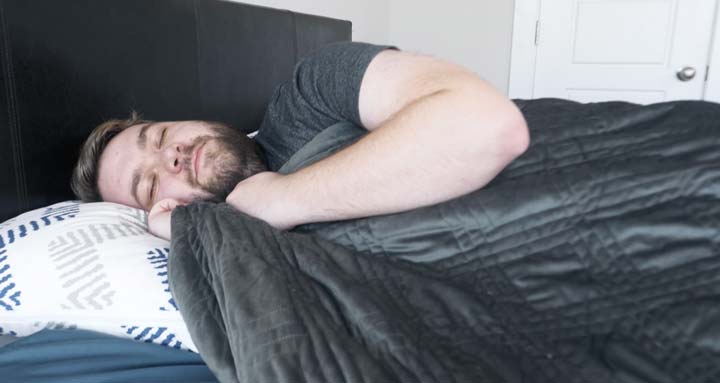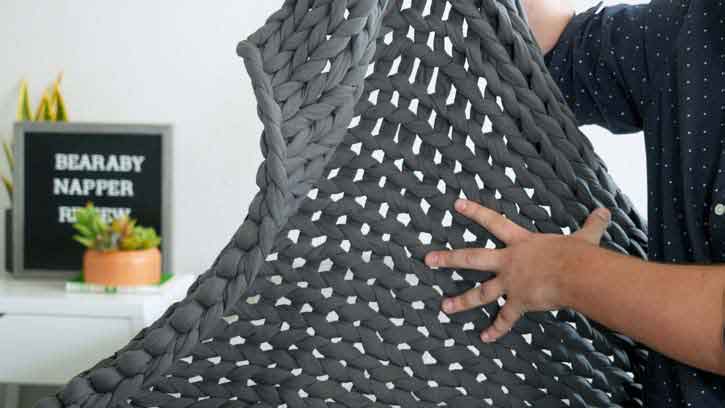Sleep problems and anxiety disorders are common issues for autistic children and adults. Weighted blankets can be very helpful tools for folks with autism spectrum disorder (ASD) combating these problems. They offer soothing deep pressure touch (DPT), and are often used by occupational therapists.
Wondering how weighted blankets work, if they could be helpful for you or your child’s needs, and which type to buy? Then you’re in the right place! This article will help you decide whether or not to buy a weighted blanket.
What is a Weighted Blanket?
Weighted blankets are blankets that have steel or glass beads, plastic pellets, or other weighted items sewn into their centers. These blankets are often quilted to ensure their fill is evenly distributed throughout the fabric. These blankets come in a variety of sizes and normally weigh between 5 and 30 pounds.
When you wrap yourself up in a weighted blanket, it will provide DPT that can increase serotonin and melatonin and decrease cortisol. This means the blankets have a calming effect on your nervous system that can ease symptoms of anxiety and sleep disorders. Weighted blankets may also have benefits for autistic people that extend beyond improving anxiety and sleep quality.

Benefits of Weighted Blankets for People with Autism
Weighted blankets may have several benefits for people with autism. I’ve listed the most common below.
- Weighted blankets may help people with sensory processing disorders reduce symptoms of sensory overload. If you are sensitive to sensory stimuli, the deep pressure therapy a weighted blanket offers can help soothe symptoms.
- If your child has meltdowns, a weighted blanket can help de-escalate them. If you’re concerned about using a weighted blanket with young children you can consider a wearable weighted vest, which is smaller and provides more mobility.
- Weighted blankets can help increase your total sleep time or help you fall asleep faster. Keep in mind that you should not use weighted blankets while sleeping. Be sure to fold it onto the end of the bed before sleep onset.
- Weighted blankets can reduce anxiety by calming your nervous system and releasing feel-good hormones like serotonin and oxytocin. Check out our best weighted blankets for anxiety roundup if you’re looking specifically for a soothing option.
- If you struggle with Attention Deficit Hyperactivity Disorder (ADHD) in addition to autism, a weighted blanket may help you reduce fidgeting or increase focus.
Do Weighted Blankets Really Help People with Autism?
So, do weighted blankets work? Well, a famous 1999 study, as well as more recent studies on DPT, found that deep pressure therapy is helpful for autistic people. It helps calm oversensitivity to touch and can reduce anxiety by soothing the nervous system and promoting the release of oxytocin, serotonin, and even melatonin in the brain.
The National Library of Medicine conducted a systematic review of weighted blanket use specifically (rather than just on deep pressure therapy) and found that weighted blankets are helpful for combatting anxiety. Additionally, the Neurological and Physical Abilitation (NAPA) Center has reported that adults and children in several different studies have self-reported that they prefer weighted blankets to regular blankets for stress relief and help sleeping.
What to Look for in a Weighted Blanket
Know you want a weighted blanket but not sure what to look for when buying one? The buying guide below should help you out! Or, take a look at the best weighted blankets of 2024 for a few ideas.
Enough Pressure to Provide a Calming Sensation
Blanket weight is a key consideration when choosing a new weighted blanket. You want the blanket to be heavy enough to offer deep pressure therapy and reduce other sensory input. But not so heavy you feel like you can’t breathe.
To get the right amount of pressure, your weighted blanket should be about 10% of your total body weight. A blanket that is only 5% of your body weight or up to 12% of your body weight may also feel comfortable. A blanket that’s too heavy may feel suffocating or cut off circulation. If you’re not sure what size blanket to choose, check out our weighted blanket calculator. You can plug in your weight to learn what size blanket will work best for you!
Cooling Features
A common complaint about weighted blankets is that they are too hot, especially in the summer months. Choosing a weighted blanket that features a cooling cover can combat this problem. Look for fabrics like Tencel that are breathable and moisture-wicking. Avoid minky fabrics, flannels, and sherpa. Take a look at our Gravity Cooling Weighted Blanket review to see our favorite cooling weighted blanket of the year.
The Correct Size
Weighted blankets also come in a variety of sizes. You may prefer a throw-sized weighted blanket (especially if you’re shopping for a child). Alternatively, there are queen sized, and even king sized weighted blankets available for purchase if you want something to fit your mattress.

Inner Fill
As I mentioned above, weighted blankets may use several different types of fill. You may prefer glass or metal filling if you’re looking for a more eco-friendly option. But plastic pellet fill may be more budget-friendly. Some weighted blankets may also use sand or food products like beans as inner fill. Keep in mind that these options are unlikely to be machine-washable. You’ll also want to pay attention to weight distribution. Look for blankets with quilting or other features that ensure the inner fill stays evenly distributed during use.
Outer Fabric
Like regular blankets, weighted blankets come in a variety of colors and fabrics. You can choose from a variety of options, including traditional minky fabrics and unique knit options (like the Bearaby weighted blanket). Be sure to choose something that feels soothing and comforting to you, especially if you’re using the blanket for sensory integration therapy.
Pro Tip: Opt for a blanket with a removable outer cover like the Sleep Number True Temp Weighted Blanket. These covers are normally machine-washable and can save you time and effort on laundry day. Take a look at our how to wash a weighted blanket article if you already have a weighted blanket with a non-removable cover.
FAQs
How do weighted blankets help people with autism?
Weighted blankets provide deep pressure touch (DPT) that can soothe the nervous system. This can help people with autism feel calmer, reduce sensory overload, and get better sleep.
Can a weighted blanket help with sensory issues?
Some people with sensory processing disorders find weighted blankets help ease their symptoms. They are often used in occupational therapy for this reason. That said, whether a weighted blanket might help you depends on your individual preferences.
What are the best weighted blankets for people with autism?
It depends on what they like! Our best weighted blankets of 2024 article offers a variety of options.

